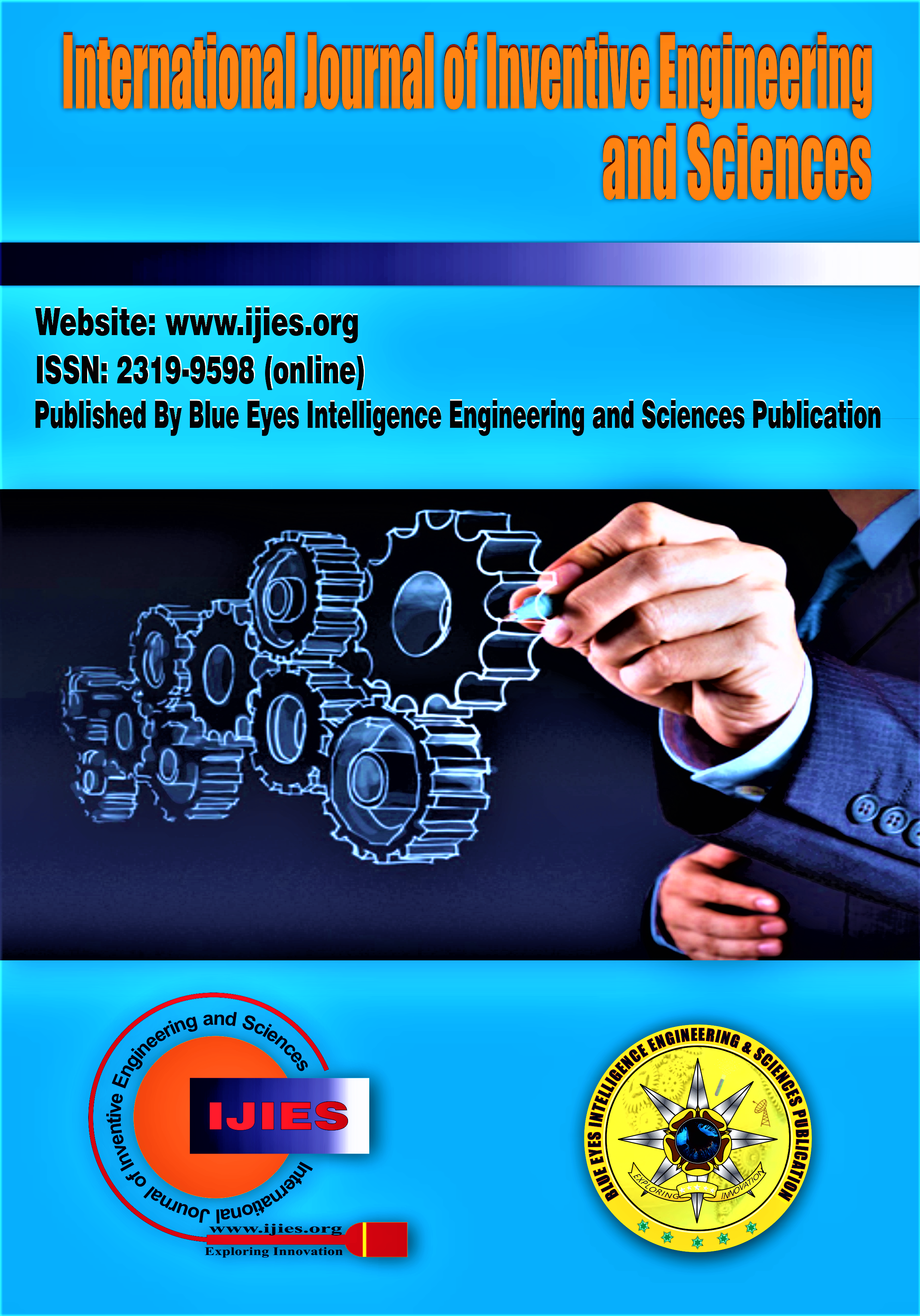Characterization of Contaminated Abattoir Soil in Swali Market, Bayelsa State
Main Article Content
Abstract
The waste effluents and waste from abattoirs have been documented to have harmful effects on the soil media, which causes threats to the living organisms and their surroundings, hence the need to characterize the contaminated abattoir soil in Swali market. Soil samples were characterized for possible contamination of physicochemical parameters and heavy metals. Six (6) soil samples were collected for six weeks at different points radially, the control was from a well of 160m from the abattoir, remaining five (5) samples were collected from various points which are 2m away from the abattoir the depth of 0.5m and 2m apart in cyclic. The soil samples were taken to the laboratory for digestion and analysis. The physicochemical parameters result showed that; pH (3.8-6.3), conductivity (56-462) µ, temperature (29) OC, TDS (38-332) ppm, SO4 (343.32-2403.24) mg/l, HCO3 (0.2-8.05) mm/l, D.O (5.1-6.3) mm/l, B.O.D (0.1-0.2) mm/l, Alk (75-250) mg/l, Acidity (50-755), while the result of heavy metals indicated; Pb (0.39-0.73) mg/l, Cr (0.06-0.113) mg/l, Mg (1.22-1.79) mg/l, Co (0.25-0.92) mg/l, Co (0.25-0.92) mg/l and Fe (2.13-8.45) mg/l/. The results were compared with FEPA and WHO standards and validated using ANOVA with Python 3.6 and SPSS software version 20 to compare the values of p and r² using different statistical models. The coefficient of determination (r²) ranges between 0.928125 and 0.996132 per cent, which is significant. Therefore, the soil around the abattoir has been adjudged to have a high level of heavy metal contamination, indicating that the soil is polluted and does not conform to standards.
Downloads
Article Details
Section

This work is licensed under a Creative Commons Attribution-NonCommercial-NoDerivatives 4.0 International License.
How to Cite
References
K.S. Mouhamed, K. Ramzi, E. Elimame, and Younes, “Adsorption of anthracene using activated carbon and Posidonia oceanica.” Vol. 7(1) Arabian Journal of Chemistry. 2014, 109–113. DOI: http://dx.doi.org/10.1016/j.arabjc.2013.11.002
E.S. Churchill and O.O. Ijaola, “Characterisation of Municipal Solid Waste in Yenagoa Metropolis and Its Associated Management Problems”, vol. 10(3), International Journal for Research in Applied Science & Engineering Technology. 2022, pp. 1460-1466. DOI: https://doi.org/10.22214/IJRASET.2022.40377
O.O. Ogunlowo, C.E. Simon, “Effect of Swali abattoir activities on the pollutant levels of Ekole River of Swali-Yenegoa about water quality standards”. vol. 60 Discovery; e1d1394, 2024. pp. 224. https://www.researchgate.net/publication/388687520
V. F. Ediene, O. B. Iren., and M. M. Idion, “Effects of Abattoir Effluent on the Physicochemical Properties of Surrounding Soils in Calabar Metropolis”, vol 4(8), Int. J. Adv. Res. 2016, pp. 37-41. DOI: https://dx.doi.org/10.21474/IJAR 01/1183
E.U. Dan, K. Raymond, M.U. Okon, “Comparative proximate,nutrient density, minerals and trace metals composition of vegetables from abattoir wastes impacted soils” vol.5 (90) J Scient Eng Res. 2021, pp. 35-53. https://www.researchgate.net/publication/330657441
S.T. Ubwa, G.H. Atoo, J.O. Offem, J. Abah, K. Asemave, “Effect of activities at the Gboko Abattoir on some physical properties and heavy metals levels of surrounding soil”, vol.5, Int J Chemist, 2013, 49-57. DOI: http://dx.doi.org/10.5539/ijc.v5n1p49
S..Ezeoha and B. Ugwuishiwu, “Status of abattoir waste research in Nigeria”, vol. 30 (2), Nigerian Journal of Technology, 2011, pp. 143-148. https://www.researchgate.net/publication/304424947
O.O. Elemile, D.O., Raphael, D.O., Omole, E.O., Oloruntoba, E.O., Ayaji, N.A., Ohwavborua. “Assessment of the impact of abattoir effluent on the quality of groundwater in a residential area of Omu-Aran, Nigeria” vol.1(1) Environ Sci Europ. 2021 pp.1- 10. https://enveurope.springeropen.com/articles/10.1186/s12302-019-0201- 5
G.U. Chibuike and S.C. Obiora, “Heavy Metal Polluted Soils: Effect on Plants and Bioremediation Methods”, vol. 10 Applied and Environmental Soil Science, 2014, pp. 1-13. DOI: http://dx.doi.org/10.1155/2014/752708
U. J. Chukwu and S. O. Anuchi,” Impact of Abattoir Wastes on the Physicochemical Properties of Soils within Port Harcourt Metropolis”, vol. 5(6). The International Journal of Engineering and Science (IJES), 2016, pp. 17-21. https://www.researchgate.net/publication/312538774
E. J. Udo and J.A Ogunwale Laboratory Manual for the Analysis of Soil, Plant and Water Samples,2nd Edition, University of Ibadan, Nigeria, 1986. https://www.scirp.org/reference/referencespapers?referenceid=2505594
Association of Official Analytical Chemists (AOAC) Methods of Analysis, 12th Edition, AOAC, Washington, C., USA,1990. https://www.scirp.org/reference/referencespapers?referenceid=2375560
I. O. Okwakpam, J Igene, and O. Amuche, “Analysis of Abattoir Soils In Yenagoa Metropolis In Bayelsa State, Nigeria,” vol 7(2) Advance Journal of Education and Social Sciences Adv. J. Edu. Soc. Sci 2022. https://aspjournals.org/ajess/index.php/ajess/article/view/52
A. B. Rabah, S.B, Oyeleke, S.B., Manga, L.G. Hassan and U.J. Ijah “Microbiological and physicochemical Assessment of soil contaminated with Abattoir effluents in Sokoto metropolis, Nigeria” vol. 5(3 Science World Journal, 2010, pp. 1-4. https://www.researchgate.net/publication/288604835
B. A Chile-Agada, F.C. Ibe, P.O. Nzenwa, “Assessment and Characterization of Environmental Impact of Effluents in the Vicinity of Owerri Municipal Abattoir”, vol.11(2) Journal of Environmental Treatment Techniques: 2023, pp.32-38 32. https://www.academia.edu/128628717/Assessment_and_Characterizati on_of_Environmental_Impact_of_Effluents_in_the_Vicinity_of_Owerr i_Municipal_Abattoir
J. Idisi and H. Uguru, “Impact of Abattoir Effluent on Microbiological and Physicochemical Properties of Water Bodies: A Case Study of Yenagoa Metropolis”, vol.4 (3) ACTA Scientific Nutritional Health, 2020. DOI: http://dx.doi.org/10.31080/ASNH.2020.04.0646
O.A. Onwuka and B.A. Uzoukwu Studies on the physicochemical properties of soil from the botanical garden, Vol. 7, Scientia Africana, 2008, pp. 156-164. https://www.researchgate.net/publication/333976045
E. Atuanya, N. Nwogu, and E. Akor, “Effluent qualities of government and private abattoirs and their effects on Ikpoba River, Benin City, Edo State, Nigeria”. Vol 6(5): Advances in Biological Research. 2012, pp.196-201. https://www.idosi.org/abr/6(5)12/6.pdf
C.M.A. Ademoroti “Standard methods for water and Effluent Analysis System. A practical textbook for water analysis, 2006, pp. 2-148. https://www.wef.org/publications/publications/books/StandardMethods /
H. Isoken. Igbinosa and E. U. Ita. “Effect of Abattoir Effluents on the Physicochemical Properties of A receiving Watershed in an Urban Community” vol.2(2):, Ife Journal of Science 2018 pp. 1-9. DOI: https://doi.org/10.4314/ijs.v20i2.2
A. Vaishaly, G. Blessy, B. Mathew, N. B. Krishnamurthy, “Health effects caused by metal-contaminated groundwater” vol.1(2): International Journal of Advances in Scientific Research, 2015, pp.60-64. DOI: http://dx.doi.org/10.7439/ijasr.v1i2.1798
R. Bala, M. Kumar, K. Bansal, R.K. Sharma, and N. Wangoo “Ultrasensitive aptamer biosensor for malathion detection based on cationic polymer and gold nanoparticles”. Biosensors and Bioelectronics Vol. 85, 2016, pp. 445-449. DOI: https://doi.org/10.1016/j.bios.2016.05.042
L. Fuortes, D Schenck “Marked elevation of urinary zinc levels and pleural friction rub in metal fume fever” vol 42(3) Veterinary and Human Toxicology 2000. 164-165. https://pubmed.ncbi.nlm.nih.gov/10839322/





